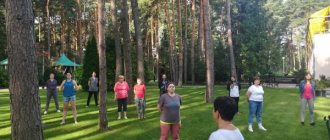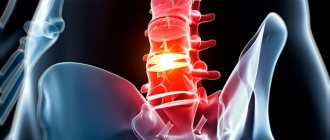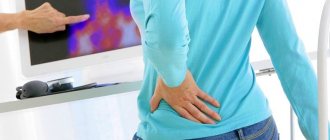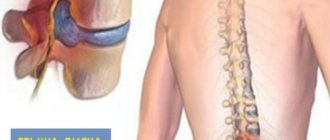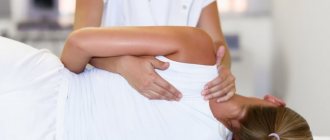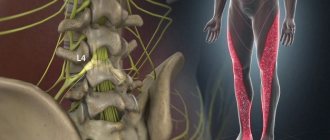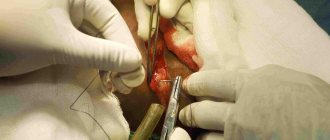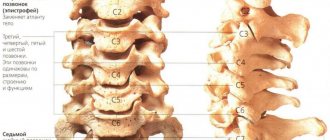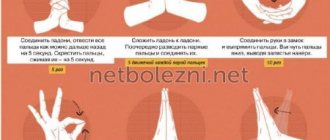A person's lower back, even if he is not overweight, always bears a very large load. After all, upright walking is the only way for a person to move. Most often, acute pain in the lumbar spine and the problems of its treatment are associated with pathology of the deep muscles of the back and with hernias and protrusions of discs.
However, when acute back pain first occurs, it is unclear what caused it. Back pain can occur due to:
- osteochondrosis and its complications, that is, with protrusions and hernias of the lumbar spine;
- spinal canal stenosis;
- inflammation of the nerve roots, or radiculitis;
- spondylolisthesis and scoliosis, when the vertebrae are connected to each other at abnormal angles;
- inflammatory conditions such as rheumatoid arthritis, tuberculosis, brucellosis.
Finally, the cause of acute lower back pain may be a paravertebral tumor or metastases to the spine. And if it is known that the cause is a hernia, then how does the lower back hurt?
What is a lumbar disc herniation
The lumbar region includes 5 vertebrae, between which are intervertebral discs. Each of them is a fibrocartilaginous formation, which consists of a fibrous ring and a nucleus pulposus.
The spinal discs perform a shock-absorbing function, that is, they soften and absorb stress on the back when moving. Thanks to it, optimal flexibility of the spinal system is maintained.
If the discs are frequently exposed to negative influences, then gradually the annulus fibrosus may become less strong. Also, due to injuries, cracks appear and other problems arise. As a result, the pulp, located in the inner part, protrudes beyond the fiber. It is this condition that is commonly called lumbar hernia.
When this pathology appears, unpleasant symptoms are observed, mobility decreases and the quality of life deteriorates. It is recommended to understand how to treat a herniated disc and use the recommendations.
How to live with a herniated disc?
How to live with a herniated disc is the main question that arises for patients who are diagnosed for the first time.
The first thing I would like to start with is to try to protect patients from the illusion that there is one golden way or method of how to live with a spinal hernia that allows you to solve the problem and forget about the hernia once and for all. Let's be objective, because a hernia is not a problem that arose here and now at the moment when it began to bother you.
A hernia is, as a rule, a long journey that begins with minor functional disorders, gradually leading to the appearance of structural disorders, which naturally culminate in the formation of a hernia. A hernia is not static; it almost never happens that today you have osteochondrosis, and tomorrow you suddenly have a hernia. When thinking about the causes and mechanisms of hernia development, the figurative expression “hernia is a lifelong journey” suggests itself. Indeed, this is almost always what happens. The causes of a hernia are described in detail here.
Hernia is a disease of modern man, to which he begins his journey in childhood. It is clear that a lot depends on genetics, on how strong the connective tissue is, which will determine the initial strength of the disc. But from the moment of birth, the role of genetics ends and the influence of acquired external and internal factors begins. What was the process of childbirth, how traumatic was it, what will be the persistence of functional biomechanical disorders that arose during childbirth and even in the prenatal period, what is their extent, will they self-correct or some of them will remain and become entrenched, continuing to influence the function, and in subsequently and the structure of the spine, how the child’s life will proceed, will he sit a lot, move little, will he lift weights from childhood, will he play sports and what kind of sport will it be, will it be amateur or professional sports, will there be children’s and In adult life, some injuries or protracted chronic diseases of internal organs may occur. Each unfavorable factor can make its own small contribution to the accumulation of herniation, overloading the discs directly from the outside or creating internal conditions in the form of the formation of asymmetrical vertebral settings that overload the discs.
Most often, a hernia is the result of something going wrong in a person’s life for a long time. Hernias are a disease of many more people than is commonly believed. Mostly people who come to doctors are those whose hernias have already begun to bother them. The rest are asymptomatic because they have not yet reached the severity at which anxiety will begin. Moreover, there is no size of hernia up to which you can live in peace, and after which you need, as they say, to start fussing and running to doctors. Even small hernias can cause serious problems. The best treatment for a hernia lies in its prevention, and if it has already appeared, in preventing its enlargement; if it is already large, in an attempt to reduce it; if neurological disorders have developed, in eliminating them as completely as possible. The common thread running through all these points should be the understanding that a hernia is a disease, the onset and development of which comes from biomechanical overloads. Only their most complete inventory can ensure long-term positive dynamics, help stop the progression of the disease, and reverse it.
When eliminating biomechanical overloads, it is important to divide areas of responsibility.
The doctor’s task is to correct internal biomechanical overloads, that is, to reduce restrictions on the mobility of structures of the musculoskeletal system in blocked areas, to improve the condition of soft tissues (muscles, fascia, ligaments, tendons), that is, to carry out corrections that have accumulated, often over many years of life, biomechanical chains that led to disc overload and the formation of hernias in them.
The patient's area of responsibility is the correction of external biomechanical overloads: eliminating heavy lifting from a forward bending position, correct lifting of loads (not by bending the body, but by squatting), eliminating twisting in the lumbar region, hyperextension in the lumbar and cervical spine, sharp, jerky movements.
But let's return to the main question - how to live with a herniated disc? Having talked about the importance and primacy of the biomechanical factor, we will analyze this issue in chronological order.
What to do if you suspect a disc herniation?
How to determine if you have a herniated disc? Let's imagine a situation where the diagnosis of a hernia has not yet been made, but the condition of the spine is already beginning to cause alarming thoughts. What to do? The answer is clear - perform an MRI of the concerned part of the spine. It is better if it is prescribed by a doctor, because the area of complaints does not always coincide with the area of the necessary examination. In what situations should you exercise caution and undergo an MRI of the spine:
- You experience, although tolerable, regular pain in any part of the spine;
- you have experienced an episode of acute pain that does not extend beyond any part of the spine, but is not relieved by taking non-steroidal anti-inflammatory drugs and muscle relaxants for 5-6 days;
- Are you experiencing regular pain in any of the following areas: arm, shoulder girdle, buttock, leg;
- You are concerned about numbness (tingling, goosebumps, burning, coldness) or weakness in an arm or leg;
- Do you engage in any kind of sport that involves lifting weights, regular exercises to develop flexibility, repetitive sharp, jerking movements, impact, or running loads.
Of course, this list of situations is not exhaustive, but it will allow many people to exercise due vigilance and identify a disc herniation or pre-herniation condition at an earlier stage, select the necessary treatment plan, and review the load.
What to do, how to live with a herniated disc when the diagnosis has already been established?
The first thing you need to understand is that the diagnosis of a herniated disc is not a death sentence. The vast majority of hernias do not require surgical treatment. The mere fact of a hernia is not an indication for surgery. Indications for surgical treatment for hernia do exist, but they are only neurological. They occur when a hernia, due to compression, disrupts the blood supply to those nerve formations whose long-term nutritional disorder is unacceptable due to the high risk of persistent impairment of neurological functions. In this case, a quick neurosurgical operation to remove the hernia is required, since if the dysfunction drags on, it will be very difficult, sometimes impossible, to restore it.
Such indications for surgery are called absolute and include:
- pelvic disorders. If a patient with a herniated disc has acutely developed pelvic disorders (urinary retention or incontinence), then he must be operated on. It is necessary to quickly eliminate compression of the nerve structures (spinal cord, cauda equina, L5 or S1 root in the presence of an additional radiculomedullary artery of Deproges-Gotteron) in order to restore blood supply to the areas responsible for impaired functions.
- development of para- or tetraparesis (weakening of both legs or legs and arms). Weakness in the arms and legs can develop with a cervical hernia, but only in the legs with a cervical, thoracic and lumbar hernia. Indicates compression and disruption of the blood supply to the spinal cord or lower lumbar roots (in the presence of an additional radiculomedullary artery). This concludes the absolute indications for surgical intervention.
In addition to absolute ones, there are also relative indications for surgery, these are indications for which surgical treatment is resorted to only if there is no effect from conservative therapy. In this case, it is important to understand the time frame that may be allocated for conservative therapy to assess its effectiveness. It is also important to understand that during these periods it is necessary to carry out not just any treatment, but the correct treatment measures, since incorrect treatment can increase the number of cases requiring surgical intervention.
So, relative indications can be:
- persistence of severe pain for 3-4 months. It is very important that the patient receives the correct treatment during this period. In practice, there are often cases when, over the course of several months, the meaning of treatment is to sequentially replace one drug with another without the use of non-drug therapy. At the same time, it often turns out that if the patient is given the correct treatment, the pain gradually recedes, even if the previous period of pain was several months. Indeed, the danger of long-term pain lies in its chronicity, which on average occurs after 3 months of the presence of regular pain manifestations. The meaning of this condition is the development of central sensitization - a condition in which overexcitation of the pain transmission and perception centers in the central nervous system occurs with the development of their increased sensitivity. This leads to a facilitated and enhanced perception of painful stimuli, and also, sometimes, to the perception of non-painful impulses as painful ones. This usually adds complexity to the treatment of patients, prolongs recovery time, and reduces the results of therapy. Therefore, it is advisable to avoid long periods of pain over many months.
It is important to note that when determining the indications for surgery based on the duration of the pain syndrome, it is necessary to take into account the duration of the severe pain. These are pains that bother a person both in vertical and horizontal positions, lying down are more associated with movements in bed, they make everyday activities impossible, interfere with the satisfaction of basic physiological needs, and concentrate all the person’s attention on painful manifestations. If within 3 months the pain has not completely regressed, but has transformed from severe to moderate or mild, then this cannot be an indication for surgical intervention, but is an indication for repeated courses of conservative therapy, which in most cases allow further reduce the severity of pain to a greater extent.
- the presence of severe muscle paresis caused by damage to one or two, maximum three roots. The roots are more resistant to hypoxia than the spinal cord, so their deep irreversible damage with the development of persistent motor neurological disorders usually develops over at least several weeks. There is no consensus on what period is critical, but most experts believe that it is 4-8 weeks. It is important to understand that during this period there must be pronounced movement disorders, that is, deep paresis, most often developing in the foot (with a lumbar hernia) or hand (with a cervical hernia). It is equally important whether the patient received adequate therapy during this time aimed at eliminating compression of the root and restoring its damaged motor fibers. If not, and the paresis has persisted for several weeks, it makes sense to start a trial therapy and evaluate the response to it. The fact is that with good recovery potential, the first response usually develops within the next 1-2 weeks from the start of proper therapy. If the severity of paresis decreases and it transforms into moderate or mild within 1-2 weeks, it makes sense to continue conservative treatment, even if the paresis has not completely regressed within 4-8 weeks, but has a clear tendency to decrease. If over the next 3-4 weeks the response in terms of reducing muscle weakness is zero, that is, deep paresis persists, subject to proper treatment, then you can consider the possibility of surgery after 3-4 weeks.
So, what to do when the diagnosis of disc herniation is already known and there are no indications for surgery. Contact specialists and engage in conservative treatment. Conservative therapy is the main method of treating patients with hernias. With widespread correct treatment, no more than 1-2% of patients would need surgery. Of course, they are performed much more often, this is due to the fact that the majority of those suffering from hernias are treated mainly only with medication and the decision to perform surgery is most often made according to indications associated with persistent pain syndrome that is not amenable to conservative treatment. However, in fact, the patient does not receive the entire necessary list of treatment, which could lead to the success of conservative therapy. Sometimes the decision to require surgery is made purely on structural grounds, in other words, on the size of the hernia, which is currently unacceptable. It is already known that the larger the hernia and the more advanced its stage, the better it resolves, especially when carrying out physiotherapeutic procedures that can stimulate resorption. Therefore, if the hernia is large, and especially transligamentous (extrusion, sequestration), but does not cause symptoms that are absolute indications for surgery, it should be treated conservatively, since in the vast majority of cases the patient recovers, and the hernia often responds to treatment aimed at stimulating resorption . In small hernias, the response to stimulation of resorption may be poorer, but in these cases surgery is not often recommended, and conservative treatment is usually effective.
How to carry out treatment?
Approaches to conservative therapy are described in detail here. Here we will pay attention to other aspects related to treatment. It can be carried out both in the acute stage and in the remission stage. An exacerbation is a stage when, in addition to biomechanical and structural, there are neurological manifestations of the disease. Remission is a stage in which there are no neurological manifestations at all (complete remission) or they are mild and inconsistent (incomplete remission). Patients are rarely in remission because there are no or minimal complaints. Moreover, if the hernia is asymptomatic and has never manifested itself, the patient, as a rule, has never received treatment for the hernia. It is usually detected by chance, if suddenly a person decides to do an MRI on his own just in case, or when he comes to be examined by a doctor as a preventive measure, any abnormalities are detected during the examination and the doctor recommends performing this study. As a rule, the patient in this case has two types of disorders - structural (the hernia itself) and functional biomechanical.
If the patient has already received treatment for a hernia, it is important what it was: if there was no gentle manual therapy correcting biomechanics and physiotherapy aimed at stimulating resorption, but only drug therapy or non-drug methods were used that did not provide correction of local biomechanical disorders and did not have a resorption effect. potential, then the patient, as a rule, retains the hernia itself, that is, there are structural disorders and biomechanical disorders - asymmetrical installations of various structures of the musculoskeletal system, including the vertebrae of the hernial zone.
Having dealt with this, it becomes clear which therapeutic measures need to be carried out in the acute stage and which in the remission stage.
In remission, the main direction of treatment is the correction of biomechanics through gentle manual therapy, as well as stimulation of resorption through physical therapy if the hernia has the potential for resorption.
In case of exacerbation, in addition to the indicated two areas of therapy, correction of neurological disorders is added; for this, in addition to manual and physical therapy, drug treatment can be used.
The frequency and number of required courses of treatment should be determined individually depending on the nature of the hernia itself and clinical manifestations, as well as on the effectiveness of the treatment. Usually it is necessary to carry out 1-3 courses of treatment. If repeated courses are necessary, the intervals between them are 4-6 months. The need for further preventive treatment and its frequency are determined individually. Most patients with disc herniations, with a treatment approach aimed at the most complete correction of all types of disorders - structural, biomechanical and neurological, recover well within 1-3 courses of treatment and do not require subsequent regular courses of therapy. An important role, of course, is played by maintaining the correct motor regimen and eliminating risk factors for relapse of the disease.
In addition to correct treatment measures, adherence to the correct regimen contributes to a speedy recovery. How to live with a spinal hernia in the acute stage? It is necessary to exclude:
- performing sudden, jerky, uncoordinated movements, lifting weights, bending forward, twisting, hyperextension of the affected part of the spine, visiting the gym. The main rule is not to provoke pain with physical activity; it must be avoided, because acute pain is a sign of traumatization of the nervous structures; its provocation will slow down recovery.
- visiting a bathhouse, sauna, taking a hot bath;
- hypothermia, exposure to drafts;
- acute and chronic stressful situations;
- drinking alcohol.
In the remission phase, the number of restrictions becomes smaller, but there is still a need to comply with some of them:
- You should not lift weights from a forward bending position, do not perform twisting and hyperextension in the lumbar region (for a lumbar hernia), or hyperextension in the cervical region (for a cervical hernia).
- gaming, active sports, running, alpine skiing, snowboarding are not the best types of physical activity for a patient with a hernia; they can cause decompensation of the disease and the development of exacerbation, especially if sudden, sharp, uncoordinated movements are performed.
- It is also better to avoid hypothermia and drafts on an ongoing basis.
Tolerance to thermal procedures (baths, saunas, hot baths) and alcohol usually improves over time, which is associated with the normalization of the functional state of the vessels of the epidural tissue. However, some patients may experience long-term sensitivity to these types of exposures. Most patients should abstain from them for at least two months.
After correction of local biomechanical disorders with gentle manual therapy and physiotherapeutic treatment aimed at stimulating resorption, dynamic observation is necessary to assess the persistence of the positive changes obtained from the treatment and the condition of the hernial protrusion. It is advisable to carry out a repeated examination aimed at assessing the state of the biomechanics and neurological sphere within a period of 2 to 6 months after the end of the course of therapy; it is advisable to perform an MRI to assess the condition of the hernia 4 months after the end of treatment, since the average time for induced resorption if treatment was carried out aimed at its stimulation are 2-6 months. Therefore, a second course of treatment, if necessary, is usually carried out after 4-6 months.
How to live with a spinal hernia after treatment?
After completing the main course of therapy, therapeutic exercises can be prescribed, the purpose of which is to consolidate more correct, more symmetrical positions of the vertebrae and create local myofixation at the level of the hernial segment. In this case, exercises should be aimed at muscles that are weakened and not overloaded by the disease, and should not injure the disc, ligamentous apparatus and nerve roots. They should not cause pain or discomfort. The effectiveness of exercises can only be counted on if they are performed on a regular basis. Long-term complexes, as a rule, are not durable; patients stop performing them as soon as it becomes easier. Complexes lasting 10-15 minutes are still performed by some patients with discipline. Therefore, the complex should include only key exercises that allow for maximum consolidation of the positive changes achieved by basic treatment.
Subsequently, if stable biomechanical and neurological compensation is maintained, the need for repeated courses of treatment is determined by the condition of the hernial protrusion. If the hernia has responded to the stimulation of resorption, has become softer or smaller, it makes sense to carry out repeated courses of treatment aimed at developing the most complete positive changes in the condition of the hernia itself. If the hernia does not respond with positive changes to stimulation of resorption, does not soften or shrink, but the patient is neurologically and biomechanically compensated and can have a full quality of life, elimination of the hernia itself should not be an end in itself. The need for subsequent treatment does not occur in all patients; it is determined by the course of the disease and is carried out according to indications.
Reasons for appearance
There are many reasons for the appearance of a hernia; they can be divided into two groups: exogenous and endogenous. The first are external, and the second are internal.
Exogenous causes:
- Tumors of different etiologies.
- Syphilis, tuberculosis.
- Back injuries.
- Excessive stress, too active lifestyle.
- Excess weight.
- Lordosis, scoliosis, osteochondrosis.
- Sedentary lifestyle. Because of this, the distribution of the load on the spine is disrupted, and the muscle corset is weakened.
Endogenous causes:
- The intervertebral discs do not receive enough nutrients.
- Dysfunction is associated with natural aging of the body.
- With age, the concentration of water in the body decreases, which leads to drying of the discs.
You can also identify risk factors that increase the likelihood of a problem occurring in the body. For example, a hernia often appears in men between the ages of 30 and 50. It is also caused by smoking, sedentary work, hypothermia, and emotional stress. It is recommended to understand how to treat a lumbar disc herniation in order to take action and improve your health. The disease tends to progress, so it cannot be neglected.
Types and stages of intervertebral hernias in the lower back
Depending on the size of the protrusion that blocks the intravertebral canal, the following types of hernia are distinguished: small, medium and large. In complicated cases, the hernia occupies up to 20% of the spinal lumen. Hernias are classified according to severity, depending on pathological changes:
- Stage I – protrusion, initial condition with slight displacement of the disc up to 4 mm. The fibrous ring becomes thinner, microcracks appear, but its integrity is maintained.
- Stages II-III – extrusion, when a hernia with dimensions of more than 5-6 mm is finally formed. The fibrous membrane ruptures, the core sags in the intervertebral canal.
- Stage IV – sequestration, a critical moment at which necrotic fragments break off from the disc and nucleus and enter the spinal canal, causing inflammation. This stage can lead to paralysis and severe autoimmune reactions.
Symptoms
The presence of a spinal hernia can be detected by characteristic signs. The pathology begins slowly, and at first there are almost no symptoms. The trigger can be a sudden movement or lifting of weight. This leads to severe pain.
The first signs are blurred, it is easy to not notice them and not ask the question of how to cure a herniated disc. A person may not pay attention to the symptoms, because they are not yet too disturbing.
The first symptoms are a feeling of fatigue in the lower back, numbness of the skin in the lower extremities, weakness in the legs and gait disturbance. Usually people attribute this to normal overwork. If nothing is done at this stage, then more obvious signs will appear. There will be pain in the lumbar region, rheas can be both weak and sharp. A person quickly gets tired when walking and suffers from muscle weakness. The skin becomes pale and vascular spots appear on it.
The most dangerous symptoms are paralysis and paresis. They appear due to compression of the spinal cord. The functioning of the pelvic organs may also be disrupted, which will lead to urine, feces and infertility. To prevent this, you need to figure out in time how to treat a hernia of the lumbar spine.
general information
Intervertebral hernia most often forms in the lower part of the lumbar spine, as well as at the point of its transition to the sacral segment. It is this area that experiences the greatest load when the body is in an upright position. Intervertebral discs normally act as shock absorbers, dampening vibration when walking, running and jumping. Increased pressure or its uneven distribution, as well as narrowing of the joint space with osteochondrosis, leads to the formation of first protrusion and then disc herniation.
Make an appointment
Diagnosis of the disease
To make a diagnosis, you will need to conduct neurological tests and instrumental studies. A neurologist will test your neurological status. This task can also be performed by a neurosurgeon or orthopedist. Diagnosis begins with an initial examination, during which a specialist evaluates muscle strength and tendon reflexes. He may suspect a hernia.
To confirm the diagnosis, the doctor will refer you for an MRI or MSCT. Based on the results of these studies, it is possible to accurately determine the disease.
Drug treatment
The doctor will most likely prescribe medication. The drugs can eliminate unpleasant symptoms, so taking anti-inflammatory or painkillers is required. For example, a doctor may prescribe Diclofenac or Ibuprofen. With the help of these drugs it will be possible to relieve pain and also prevent muscle tissue atrophy.
If the patient feels stiffness of movement or suffers from spasms, then the doctor will prescribe Mydocalm and Sirdalud. These are relaxing remedies that will quickly improve the patient’s well-being.
There are other answers to the question of how to cure a hernia of the lumbar spine. It is necessary not only to take medications, but also to undergo some other procedures.
Establishing diagnosis
The diagnosis is made after examination and examination of the patient. First of all, instrumental diagnostics are carried out to help determine whether the tendon reflexes are normal. The patient is asked to raise his straightened leg. Tests are also carried out for sensitivity to vibration, the ability to sense temperature and pain. If there is a hernia, there will be certain manifestations:
- The doctor will determine the sensitivity disorder.
- The patient's movement biomechanics will be changed.
- Tendon reflexes will deviate from normal.
Also, to diagnose protrusion, CT or MRI diagnostics of the spine is performed. These studies will help not only visualize the hernia, but also determine the condition of the surrounding tissues and diagnose narrowing of the spinal canal, if any. If indicated, contrast myelography may be prescribed. After the examination, the degree of pathological changes can be determined and adequate treatment can be prescribed. If the nerves are not affected, the patient complains only of pain, conservative therapy is used.
Physiotherapy
In case of a hernia, doctors strongly recommend exercise therapy, since the gymnastic complex helps prevent the progression of the pathology. The exercise should be performed only after the discomfort disappears. The treatment program is prescribed by the instructor, focusing on the individual characteristics of the patient.
The main goal of the treatment program is to improve muscle condition and prevent further changes in the position of the disc. The patient will have to bend, lift, rotate the arms and body, as well as other exercises.
There are other physiotherapeutic methods of treatment, for example, influencing special points with needles, treatment with warm compresses. Spinal traction is also performed using the Ormed apparatus. All this allows you to quickly improve a person’s health.
Advantages of the clinic
“Health Energy” is a modern multidisciplinary clinic that diagnoses and treats various diseases in adults and children. We offer:
- consultations with doctors of various profiles;
- comprehensive diagnostic programs to assess the condition of the body;
- targeted examinations to make a specific diagnosis or exclude it;
- organizing remote consultations with foreign doctors to obtain an alternative opinion;
- modern and time-tested treatment regimens, selected individually;
- physiotherapy, massage, physical therapy and other auxiliary treatment methods;
- all types of certificates and conclusions, registration of certificates of incapacity for work;
- organization of rehabilitation after illnesses and injuries;
- organization of sanatorium-resort treatment.
A hernia of the lumbar spine seems harmless only at first glance. It is this pathology that can most likely lead to complete or partial paralysis of the legs and a disorder of the pelvic functions. Do not bring the disease to its extreme stage; in the early stages it can be eliminated without surgery. Sign up for a consultation with the neurologists at Energy of Health.
Surgery
In advanced cases, the doctor may prescribe surgery. Surgical intervention cannot be avoided when the source of inflammation is in the area of the sciatic nerve, the disc has ruptured, or its position has changed significantly.
A procedure such as a discectomy may be performed. It involves removing part of the disc using a special needle. In addition, the problem area can be treated with a laser. This eliminates excess fluid and frees the nerve. In extreme cases, the doctor can remove the weight disc and then perform prosthetics.
Operation
Radical intervention is used when it is necessary to free the spinal cord and nerves from the pressure of protruding tissues. The most popular methods are:
- Endoscopy is an operation through an incision in the spine using a probe. A camera and instruments are inserted through a small hole, and displaced tissue is removed.
- Disc endoprosthetics. Damaged elements are removed. A prosthetic structure is installed in their place.
- Percutaneous discectomy. Access is made through a puncture, the deformed core is removed and replaced with a special compound.
- Laser reconstruction – the hernia is removed by evaporating moisture from the tissue.
Prevention
It is easier to prevent a disease than to cure it, so you need to take care of prevention. Typically, a hernia appears against the background of sudden or regular stress. You should not overwork, lift heavy objects, or make sudden movements. For sleep, you should choose orthopedic massage. It is recommended to fall asleep on your back, as this is the most favorable position.
It is important to prevent the appearance of excess weight, as it leads to many health problems. You must not forget about correct posture and try to keep your back straight.
If the pathology is not treated, it will lead to intense pain, problems with the genitourinary system, and muscle weakness in the legs. To prevent this, you should consult a doctor in a timely manner and begin therapy. The result will appear quite quickly; symptoms should subside within the first week if the treatment is chosen correctly. The main thing is to follow the specialist’s recommendations and try to eliminate the causes that can lead to the progression of the pathology.
Complications
If a hernia is diagnosed at an early stage, following the doctor’s recommendations allows you to completely get rid of the protrusion. If the patient neglects treatment, the formation increases. Ultimately, this process can cause serious complications. Particles of the disc completely block the spinal canal, compressing the passing nerve roots. Cauda equina syndrome develops, manifested by:
- severe pain;
- loss of control over urination and bowel movements;
- complete or partial paralysis of the lower limbs.
The condition requires immediate surgical attention as nerve function can be restored if the compression is relieved within 24 hours.
